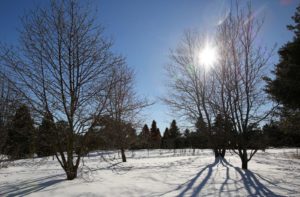
Saturday was a bright, sunny day, and if you were walking by an undisturbed field of snow, the snow may have appeared to sparkle.
Snow sparkle is caused by light reflecting off ice crystals that have settled on the top of the snow.
When light hits an object three things happen. The light can be reflected, in which case it bounces off in a new direction; it can be absorbed, in which case the object is heated; and it can be transmitted, in which case light passes through the object. The law of reflection states that when light is reflected from a smooth surface, the angle of reflection is equal to the angle of incidence and the two rays lie in the same plane.
Snow is made of ice crystals, and as a crystal gently falls on a surface, it may lie relatively flat. Some crystals are smooth and can act like mirrors and reflect light. When conditions are right, rays of light hit individual ice crystals that are on the uppermost layer of snow and reflect the light upward, at the angle of reflection. The reflected light will be bright, a small image of the sun.
For the light ray to hit your eye and become visible, the crystal has to be lying at the correct angle on the surface so the angle of reflection sends the beam your way. Of the thousands of ice crystals lying on the surface, you see only those that align correctly. If you move, you encounter different crystals that also are at the correct orientation.
Dry conditions can increase the likelihood of seeing snow sparkles because ice crystals often stay separate in drier conditions. Warmer days decrease the likelihood of seeing snow sparkles because, as the crystals may melt, they merge together and may not lie as a flat reflective surface.

